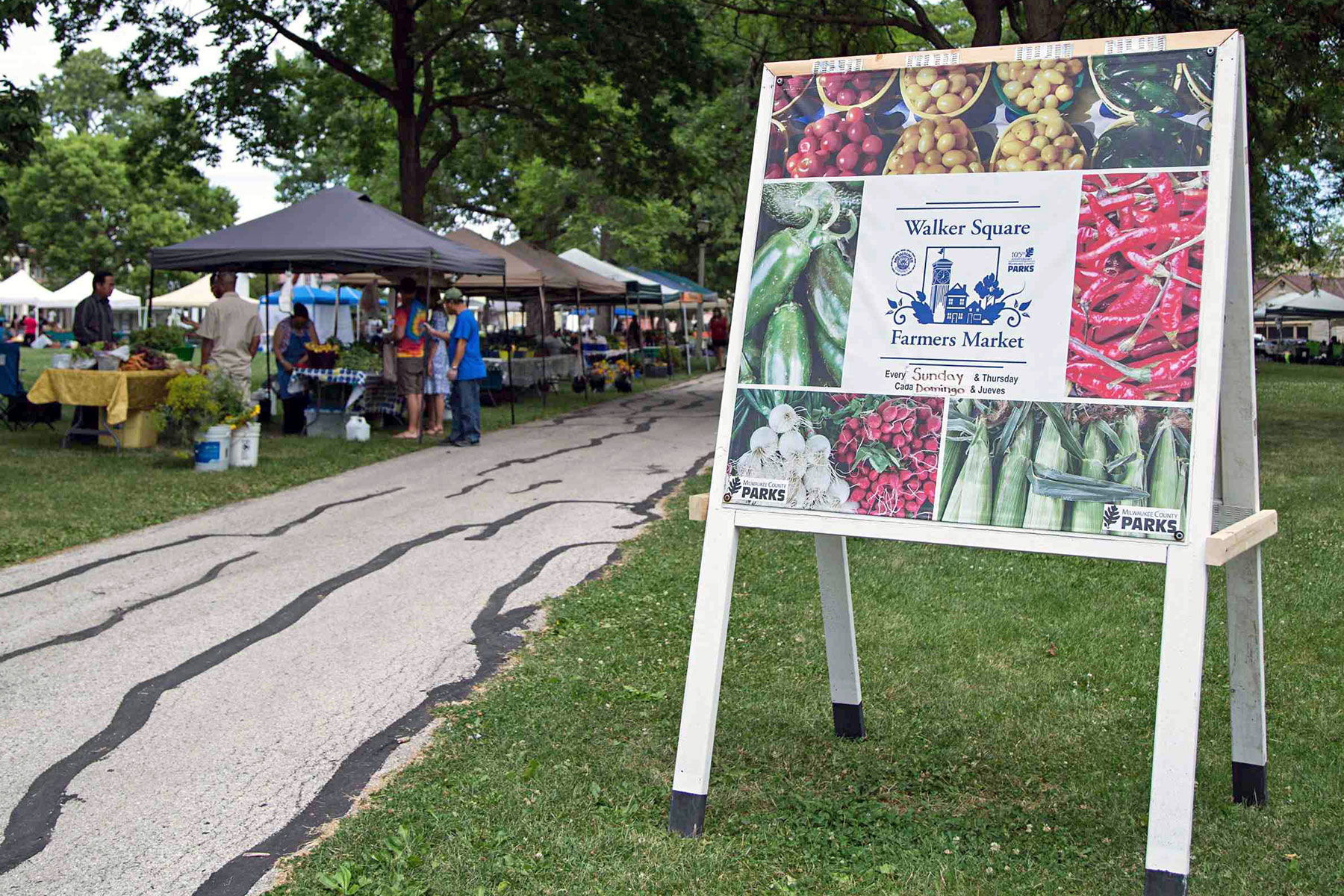
Farmers markets provide many benefits for communities of all sizes. They offer a physical location for people to connect with their neighbors, access farm-fresh and healthy foods, and learn more about how food is grown. In addition, farmers’ markets help generate economic activity at local businesses and may attract tourists looking for a special “taste of place.”
Perhaps most importantly, farmers’ markets provide an opportunity for small and medium-sized farms to reach consumers directly and retain a larger share of profit from their products’ sales. Around the nation, farmers’ markets are on the rise. The U.S. Department of Agriculture reports that the national total of farmers’ markets doubled from 4,385 in 2006 to more than 8,669 in 2016. Wisconsin has kept pace with this nationwide trend, hosting approximately 265 markets in 2017, according to Kristin Krokowski, director of the Wisconsin Farmers Market Association and an educator with University of Wisconsin-Extension Waukesha County.

However, many of these markets fail within their first four years in business. While the number of farmers’ markets has swelled, inexperienced management, high manager turnover, small size and low resources can make a market more susceptible to collapse.
Farmers’ markets are also facing increased competition with a growing number of local food outlets, including community supported agriculture shares, grocery stores and online marketplaces. Moreover, the growing number of farmers’ markets give consumers many options for shopping for locally grown products. Small, new and under-resourced markets may struggle to stay in operation in this crowded field.
Limited time, meager or non-existent budgets for marketing and a lack of formal training in marketing can further complicate the job of managing a farmers’ market, but creative promotion and careful planning can help draw potential customers, grow a base of support and survive stiff competition.
Helping markets succeed
In 2017, a team of researchers at UW-Madison and UW-Extension surveyed market managers from around Wisconsin and compiled their findings in a report titled “Plan, Partner, and Promote: Best Marketing Practices from Wisconsin’s Farmers Market.” It details how they have successfully navigated challenges and achieved long-term stability.
The surveyed market managers recommended new and struggling markets begin by creating a detailed plan for promotion and outreach. Growing a social media following and otherwise developing a digital presence through resources like websites and email newsletters are among their suggestions, but some market managers also utilize a more traditional word-of-mouth approach by reaching out to community organizations like nonprofits, churches, food pantries, schools and local associations to disseminate information.
Businesses and organizations within communities often engage in valuable partnerships with their local markets through in-kind donations, promotion or other support. In DeForest, for example, a local credit union helped the community farmers’ market purchase card readers that allowed them to accept and process credit, debit and EBT payments. In exchange, the market manager mentions the credit union on social media and permits the distribution of branded shopping bags during the market.
Other engagement tactics, like market-wide giveaways that offer a prize basket with items from vendors or partnering organizations can help to raise a farmers’ market’s profile. By giving visitors something to discuss, markets can increase buzz among friends and family, swelling attendance numbers.
Managers of successful markets also cited clarity, uniformity and pleasing design in market and vendor signage as a feature that can help a market appear more organized and alluring to potential customers. Displays that detail the origin, growing practices or production techniques of products can appeal to patrons seeking local or organic goods and help to convey the vendors’ stories.
Finally, evaluation can be essential to the success of a burgeoning farmers’ market. Once attainable goals are set, the manager can study how customer counts, surveys and sales data change over time to understand how outreach efforts have improved the market’s continuing viability. More information on transforming a market from a growing concern to a going concern can be found in the report.
* * *
As many Wisconsinites know, not all farmers’ markets are the same, but they are found in all types of communities – cities, small towns, suburbs and rural areas. With differences in size, rules and management styles, many of these markets offer unique features and face diverse challenges in providing localized access to fresh foods and other products.
Farmers market managers in Wisconsin, along with other people who support farmers’ markets, expressed interest in learning more about what practices and features are common across the state. Researchers at the University of Wisconsin-Extension and the UW-Madison College of Agricultural & Life Sciences conducted a survey in 2017 to help answer their questions. It was based on self-reported data – primarily provided by market managers – about their practices and markets’ characteristics.
Urban shoppers can expect larger markets, with an average of 68 vendors. Markets in suburban areas host an average of 48 vendors during peak season. In small towns, markets tend to be smaller, with around 25 vendors, slightly more than the average of 21 vendors operating at rural markets.

Regardless of size, farmers’ markets offer an important venue for farmers to participate in their local economies (like a youth entrepreneurship program in Brown County), with 88 percent of markets reporting sales of locally produced products. By comparison, just 16 percent said they also sell non-local products. Only half of the responding markets had prepared food vendors, which may point towards a potential avenue for growth.
Although 86 percent of markets offer free parking, other means of access may be limited, making convenient transportation a potential barrier to market patronage. Fewer than half of markets are adjacent to a bus stop or offer bicycle racks. Despite this concern, research suggests that low-income Wisconsin residents generally do not perceive market locations and hours as inconvenient.

Wisconsinites who utilize food assistance programs may find inconsistent applicability; 65 percent of markets accept Women, Infants and Children Farmers’ Market Nutrition Program benefits, and 42 percent accept electronic benefit transfer cards, which allow people to access benefits from the federal Supplemental Nutrition Assistance Program. Low SNAP participation may be explained in part by other research focused on Wisconsin farmers’ market managers, which found that accepting EBT or SNAP benefits can be labor intensive and expensive.
Many markets, many variations
Most farmers markets in Wisconsin are independent operations, leading to a wide variety of rules, funding sources and product types. Forty percent of markets operate as their own entity, and another 28 percent are run by a parent organization that does not operate another market. Local governments and business associations each run around 13 percent of markets, and organizations with multiple markets account for 4 percent. Around 6 percent of respondents did not provide details on their markets’ operations.
The administrative split between standalone markets and those that have the support or resources of a larger affiliate organization structure has a strong impact on funding and other resources. Most markets that are not run by a city or other local government do not receive substantial support from those entities.
Product guidelines and other rules, as well as their enforcement procedures, also vary by market. Sixty-nine percent of markets reported enforcing some rules related to where products were grown, how products were grown, or if reselling is allowed, among others. Fifteen percent have rules that are unenforced, and only 6 percent have no rules for vendor practices. Ten percent did not specify product or vendor rules.
Managers employ a number of rule-enforcement strategies, such as observing vendors during the market to see that products match what is allowed at the market, assessing whether a product would likely be available given the growing season, relying on other vendors to report problems, requiring copies of licenses or permits, and having vendors sign agreement forms in advance of the season. Managers may also conduct on-farm visits. To address problems, some managers use a point system, wherein points are docked when rules are broken, while others issue verbal or written warnings.
Requirements for participation differ, but three-quarters of markets impose some type of fee for vendors. Of those markets that require fees, only 29 percent have a single flat fee for vendors. The rest primarily charge different amounts based on how often vendors attend. Few markets charge different fees based on the type of product sold, location of the stall or vendor sales, and none determine fees by seniority.
Of markets that charge fees, almost 90 percent report the weekly fee to be between $1-30. Another 6 percent report a fee under $40 for the entire season, and 2 percent report a weekly fee of $31-60.
Managers make markets happen
Market managers play a key role in ensuring the success of local farmers’ markets, and often provide a variety of services like marketing, accounting and administration. Around 83 percent of managers supervise a single market that meets at one location, while another 15 percent are involved with one market that meets at multiple locations or on multiple days. 2 percent did not respond. Overall, 42 percent of market managers have held the position for two years or less, suggesting some markets may experience high turnover in the role.
Despite the breadth of duties many market managers undertake, the role is a part-time endeavor for most, who average 11-20 hours of work each week. Managers of larger markets tend to put in longer hours than those of smaller operations, but their weekly averages still fall between the 16-to-20 hour range.
Around a third of market manager positions are unpaid, particularly at smaller markets where 40 percent of managers are not compensated for their time. Thirteen percent of managers at large markets are uncompensated. Of managers who are paid, respondents most frequently report that the wages run between $13-16 per hour.
Managers are involved in decision-making at most markets, with vendors providing direction at around a third, and customers weighing in at 4 percent of responding markets. Around half of all markets have boards of directors, but these are more prevalent among large markets, with 62 percent utilize this structure compared to 42 percent of small markets.
An objective of this survey was to provide clarity to market managers about common practices across the state. Another goal was to help UW-Extension and partners better help farmers markets sustain themselves, as they provide communities a variety of economic, social and health benefits. Understanding the nature of Wisconsin’s farmers markets is a step in this direction.
Marlie Wilson and Laura Witzling
Originally published on WisContext.org, which produced the article in a partnership between Wisconsin Public Radio, Wisconsin Public Television and Cooperative Extension.













